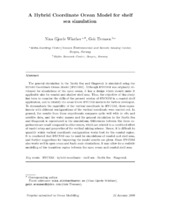A Hybrid Coordinate Ocean Model for shelf sea simulation
Journal article
Submitted version
Permanent lenke
https://hdl.handle.net/1956/1272Utgivelsesdato
2006-03-03Metadata
Vis full innførselSamlinger
Originalversjon
https://doi.org/10.1016/j.ocemod.2006.01.004Sammendrag
The general circulation in the North Sea and Skagerrak is simulated using the Hybrid Coordinate Ocean Model (HYCOM). Although HYCOM was originally de- veloped for simulations of the open ocean, it has a design which should make it applicable also for coastal and shallow shelf seas. Thus, the objective of this study has been to examine the skills of the present version of HYCOM in a coastal shelf application, and to identify the areas where HYCOM needs to be further developed. To demonstrate the capability of the vertical coordinate in HYCOM, three exper- iments with different configurations of the vertical coordinate were carried out. In general, the results from these experiments compares quite well with in situ and satellite data, and the water masses and the general circulation in the North Sea and Skagerrak is reproduced in the simulations. Differences between the three experiments are small compared to other errors, which are related to a combined effect of model setup and properties of the vertical mixing scheme. Hence, it is difficult to quantify which vertical coordinate configuration works best for the coastal region. It is concluded that HYCOM can be used for simulations of coastal and shelf seas, and further suggestions for improving the model results are given. Since HYCOM also works well in open ocean and basin scale simulations, it may allow for a realistic modelling of the transition region between the open ocean and coastal shelf seas.
